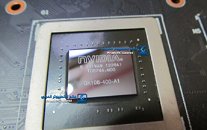Sunday, September 2nd 2012

NVIDIA GK106 GPU Pictured, GeForce GTX 660 Benchmarked
Here are some of the first pictures of NVIDIA's upcoming GK106 silicon, which goes into building the GeForce GTX 660 graphics card. The GK106, built on the 28 nm silicon fab process, is poised to be NVIDIA's newest mainstream-performance chip that succeeds the GF116. The pictures reveal the chip package to be almost as big as the GF116 but smaller than the GK104. This can be attributed to fewer memory I/O pins (192-bit maximum bus width).
The rectangular die of the GK106 appears to have roughly the same area as that of the GF116, but with the higher transistor density of the 28 nm process, one can expect a significantly higher transistor count for the chip. If some of the pictures we're seeing are any indication the GK106 will be extremely energy-efficient, as an unknown graphics card based on it draws power from just one 6-pin power connector.According to the specifications leaked from various sources, some of which include the source of these pictures, the GK106 as GeForce GTX 660 features 960 CUDA cores, 24 ROPs, and a 192-bit wide GDDR5 memory interface, holding 2 GB memory. The card could ship with clock speeds of 980 MHz core, 1033 MHz GPU Boost, and 6.00 GHz memory. At reference speeds and on-spec voltage, the chip could feature a typical power draw of 140W, which explains the need for just one 6-pin power connector.
Some of the sources managed to get a GeForce GTX 660 sample running with GeForce 305.27 beta drivers, and put it through 3DMark 11. Below are the GPU-Z screenshot (with some fields blanked out by the source), 3DMark 11 Performance preset and 3DMark 11 eXtreme preset numbers.
Sources:
Arab PC World, 3DCenter.org, VideoCardz
The rectangular die of the GK106 appears to have roughly the same area as that of the GF116, but with the higher transistor density of the 28 nm process, one can expect a significantly higher transistor count for the chip. If some of the pictures we're seeing are any indication the GK106 will be extremely energy-efficient, as an unknown graphics card based on it draws power from just one 6-pin power connector.According to the specifications leaked from various sources, some of which include the source of these pictures, the GK106 as GeForce GTX 660 features 960 CUDA cores, 24 ROPs, and a 192-bit wide GDDR5 memory interface, holding 2 GB memory. The card could ship with clock speeds of 980 MHz core, 1033 MHz GPU Boost, and 6.00 GHz memory. At reference speeds and on-spec voltage, the chip could feature a typical power draw of 140W, which explains the need for just one 6-pin power connector.
Some of the sources managed to get a GeForce GTX 660 sample running with GeForce 305.27 beta drivers, and put it through 3DMark 11. Below are the GPU-Z screenshot (with some fields blanked out by the source), 3DMark 11 Performance preset and 3DMark 11 eXtreme preset numbers.





41 Comments on NVIDIA GK106 GPU Pictured, GeForce GTX 660 Benchmarked
kick iz ass c-bass :shadedshu
---------7970GE
GTX680 > 7970
GTX670 > 7950
GTX660Ti>7870
and probably:
GTX660>7850
Performance wise is like 95% of 7870
and price i don't think it will sell for less than $240, the street price of 7870
So, for al intents and purposes the gtx 660 is directly competing with 7870.
670 - 7950
660Ti - 7870
660 - 7850
650 - 7770
Performance for all cards is better than the AMD counterpart (except we still don't know what that 650 will be) that is why some people tend to compare the lower ranked NV card vs. the higher ranked AMD, prices are better for AMD after three cuts that's why you have the 7870 at 240$. NVidia on the other hand is still going more or less with launch prices. The market will decide if they need to adjust prices.
It's like the potato argument...you say that, i say price is the key to who competes aganist who.
GTX680 $480 - 7970Ghz $430
GTX670 $380 - 7970 $420($390 w/reb)
GTX660ti $300 - 7950 $300($290 w/reb)
GTX660 $250?- 7870 $250($230 w/reb)
Sticking with the "mine is bigger than your wang" attitude sort of hurt Nvidia since, when O/C, the GTX 660ti, GTX 670, and GTX 680 all come very close to each other. So close in fact that it probably cause a lot of buyer remorse.
As for AMD, the "I'm a big boy too attidude" made for a confusing lineup. Outside these tech forums, no one knows the differance between a 7950, 7950 GHZ, 7970, and 7970 GHz. After dropping the non-GHz 7900s, spacing seems much better than Nvidias though.
680 > 670 > 660ti >> 660 >>>>>>>>>>>>>>>>>>>>> 650
7970ghz >>> 7950Ghz >>> 7870 >>> 7850.............